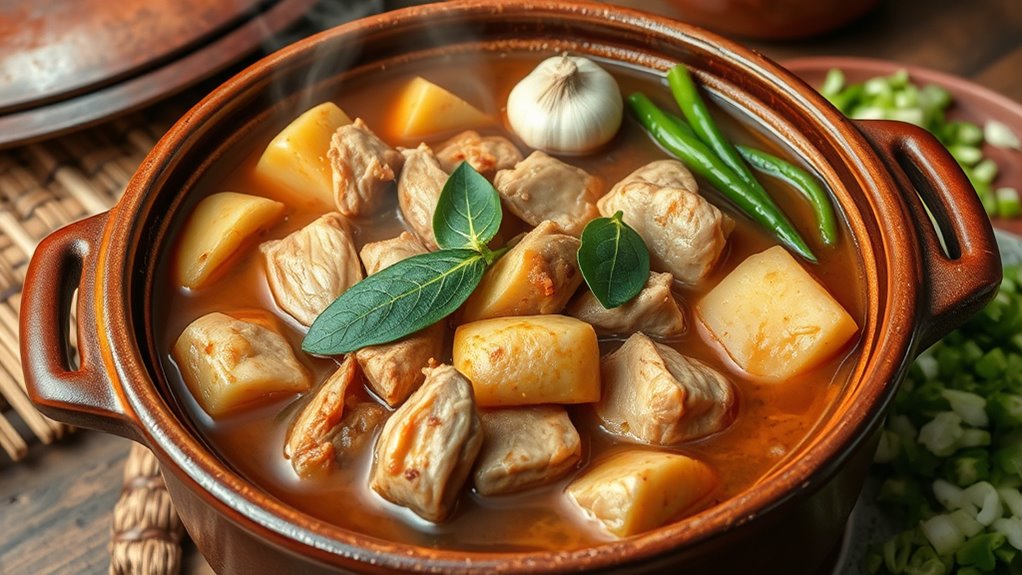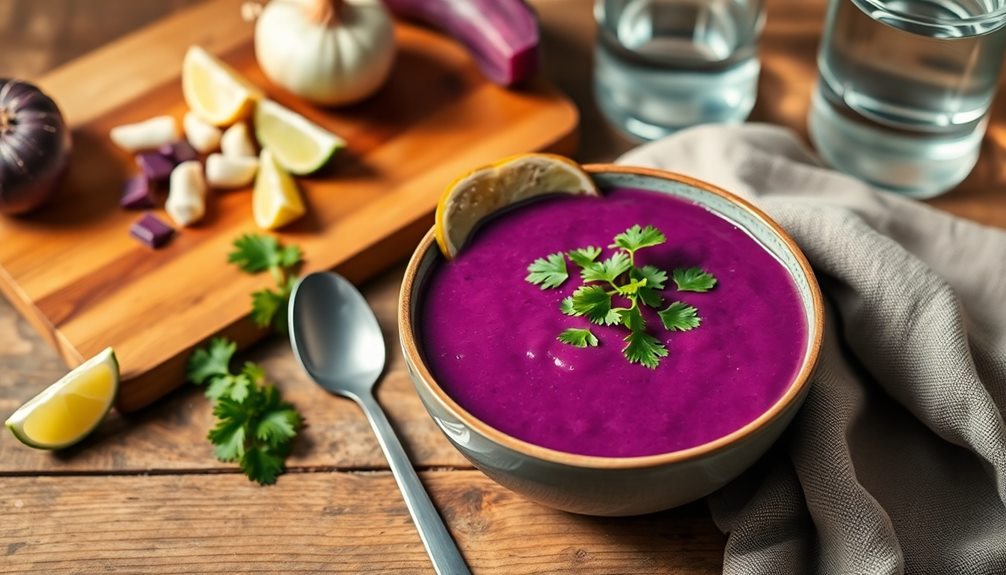Absolutely, you can enjoy Filipino adobo without soy sauce by using regional ingredients and flavor substitutes. Coconut aminos offer a similar umami taste with a touch of sweetness, while fish sauce adds saltiness and depth. Incorporating coconut milk or local herbs like lemongrass and turmeric can give your adobo unique regional twists. These options help you create a flavorful, satisfying dish that respects traditional flavors while accommodating dietary needs. If you continue exploring, you’ll discover even more variations to suit your taste.
Key Takeaways
- Soy-free adobo can be made using coconut aminos, fish sauce, or citrus to replicate umami and tangy flavors.
- Regional variations incorporate ingredients like coconut milk, lemongrass, or turmeric to create unique flavor profiles without soy.
- Different meats such as chicken, pork, or seafood can be used to diversify the dish while maintaining authenticity.
- Balancing acidity with vinegar or citrus compensates for the absence of soy sauce’s savory depth.
- Adobo’s versatility allows for regional ingredient adaptations, celebrating Filipino culinary diversity without soy.

If you’re craving the classic Filipino adobo but want to avoid soy sauce, there are flavorful alternatives that can deliver the same rich taste. Adobo’s history origins trace back centuries, rooted in indigenous cooking methods blended with Spanish influences. Traditionally, soy sauce became a key ingredient, giving adobo its signature salty, umami flavor. However, regional variations and dietary preferences have inspired cooks to experiment with different ingredients, creating delicious soy-free versions without losing the dish’s essence.
Many people associate adobo with its characteristic tang and savory depth, which can be achieved through various flavor variations. For those avoiding soy sauce, coconut aminos serve as a popular substitute. They bring a similar umami profile with a slightly sweeter, milder taste, making them an excellent alternative. Other variations include using fish sauce, which adds saltiness and depth, or incorporating vinegar and citrus to enhance the tang. These substitutions help retain the complex layers of flavor that define adobo.
Coconut aminos mimic umami with a sweeter note, perfect for soy-free adobo.
If you’re exploring regional twists, you might try adobo with indigenous ingredients. For example, in coastal areas, coconut milk is sometimes added to create a creamier, richer dish. In some regions, local herbs like lemongrass or turmeric are incorporated to give the dish a fragrant, distinctive twist. These flavor variations not only cater to dietary needs but also celebrate regional ingredients, highlighting how adaptable adobo can be. Additionally, understanding the legislative changes related to food ingredients can help you stay informed about safe and approved substitutes, ensuring your dish remains both delicious and compliant.
You can also experiment with different cuts of meat or even vegetables, which influence the overall flavor profile. Chicken remains the most popular choice, but pork, beef, or even seafood can be used to add variety. When avoiding soy, focus on balancing acidity with vinegar or citrus to compensate for the umami you’d typically get from soy sauce. It’s also helpful to learn about alternative flavoring agents, which can provide depth and richness to your adobo. Incorporating cultural influences can inspire new twists and keep the dish exciting. Recognizing the variety of regional flavors helps in creating a unique and authentic experience with each version. This approach ensures your adobo remains flavorful, tender, and satisfying.
In essence, you don’t have to sacrifice taste when skipping soy sauce. The history origins of adobo show how versatile the dish is, thriving through countless regional flavor variations. Whether you opt for coconut aminos, fish sauce, or fresh herbs, you can craft a soy-free adobo that’s just as hearty and flavorful as the traditional version. It’s all about experimenting with ingredients and embracing the rich culinary heritage that makes adobo a beloved Filipino classic.
Frequently Asked Questions
Can Adobo Be Made Without Vinegar?
Yes, you can make adobo without vinegar by using vinegar substitutes like apple cider vinegar, lemon juice, or tamarind. These alternatives preserve the tangy flavor, though they create flavor profile variations. You might notice differences in acidity and brightness, but the dish remains delicious. Experimenting with these substitutes allows you to customize adobo to your taste, especially if you’re avoiding vinegar or want to explore new flavor twists.
What Are Alternative Ingredients to Soy Sauce?
If you’re looking for fermentation alternatives or umami substitutes to soy sauce, you have options. You can try tamari, coconut aminos, or mushroom soy sauce for richer flavors. These ingredients bring depth and umami to your dishes without traditional soy sauce. Experimenting with these alternatives allows you to customize flavors, especially if you’re avoiding soy or seeking regional variations. They’re easy to incorporate and can enhance your recipes beautifully.
How Does Adobo Without Soy Sauce Taste?
Imagine a dish where the familiar umami savoriness takes a different turn—that’s what adobo without soy sauce offers. Its flavor profile becomes brighter and slightly tangy, highlighting ingredients like vinegar, garlic, and citrus instead. The ingredient substitution shifts the traditional depth, making each bite feel lighter yet still rich. While it lacks soy’s signature saltiness, it creates a unique, invigorating take on a classic, inviting you to explore new flavor dimensions.
Are There Regional Adobo Variations Without Soy Sauce?
You’ll find that some regional adobo variations skip soy sauce, highlighting unique flavor profiles. In these versions, ingredient substitutions like vinegar, calamansi, or coconut milk create different tastes that reflect local traditions. By experimenting with these alternatives, you can enjoy a diverse range of adobo flavors. These variations showcase how regional ingredient choices influence the overall profile, making each version distinct and delicious without relying on soy sauce.
How Long Does Adobo Without Soy Sauce Last?
Think of adobo without soy sauce as a delicate treasure that needs careful handling. When stored properly in an airtight container in the fridge, it can last up to 3 to 4 days. To prevent spoilage, you should reheat it thoroughly before serving and avoid leaving it out at room temperature. For longer storage, freeze it, and enjoy within a month to keep its flavor and freshness intact.
Conclusion
Without soy sauce, Filipino adobo becomes a blank canvas waiting to be painted with your preferred flavors. It’s like a garden in spring, bursting with fresh potential and unique regional hues. By exploring these variations, you craft a dish that’s as vibrant and diverse as the Philippines itself. So, don’t hesitate to experiment—your adobo can be a flavorful journey, revealing new tastes and aromas that make each bite an exciting adventure.










